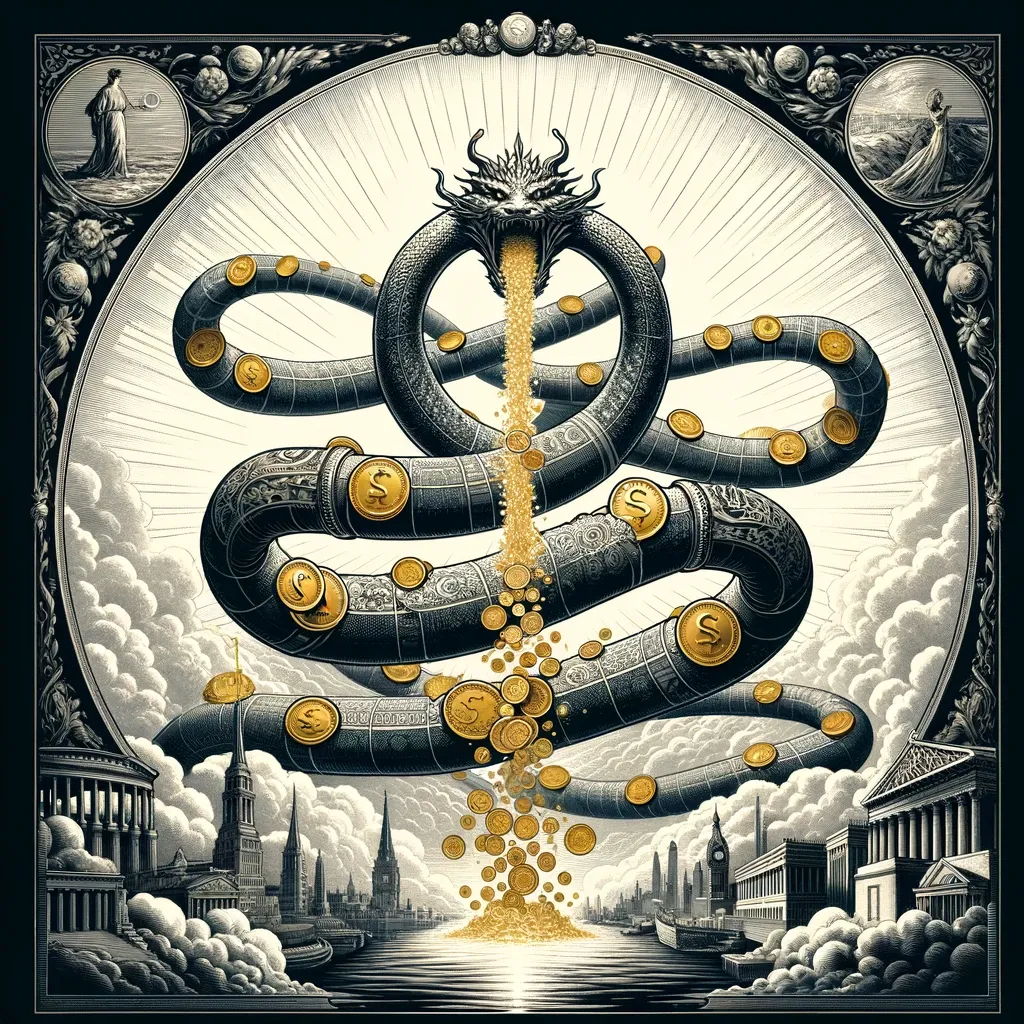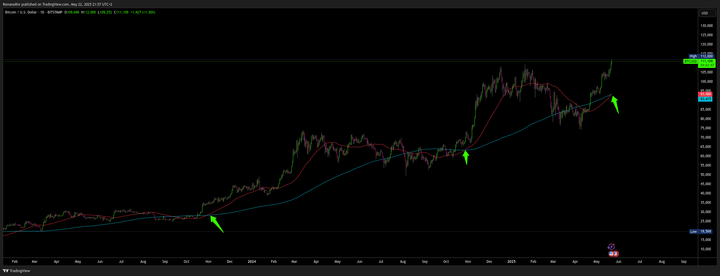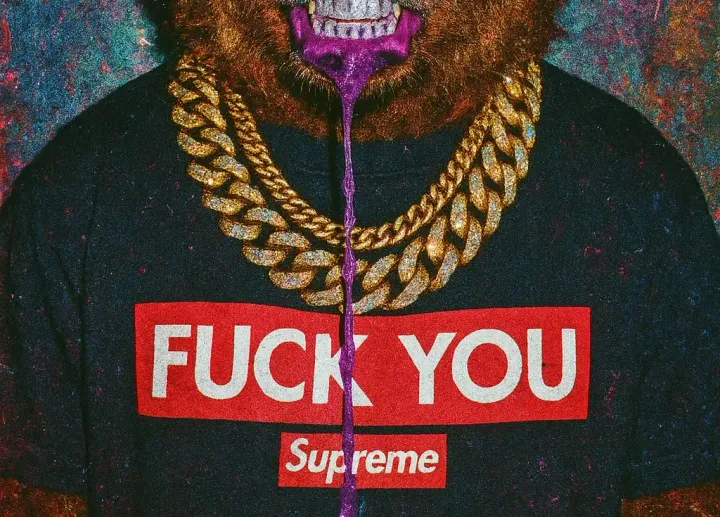$350 Billion Stealth Injection into the financial system

Why did everything pump? Seasonality, year-to-end rally, Bitcoin spot ETF, or was it $350 Billion injected into the financial system?
There were several factors that contributed to the November rally in the stock market.
- These included unprecedented buying from CTAs
- massive buybacks by corporations exceeding $5 billion
- extreme dealer gamma
- Tactical short squeeze on hedge funds
- Seasonal trends
- AI hype
- Q3 earnings season that surpassed expectations
Most of it, I managed to cover on Discord, but still, the rally was beyond my expectations, despite the corporate buy-backs and CTAs going full ape. I just couldn't figure it out.

However, there was another significant factor at play. Central banks injected a massive amount of liquidity into the financial system.
This came to light after extensive research by Goldman Sachs and the November rally made sense.
Some advanced alchemy of financial engineering by central banks of the G4 countries along with China.
In November, there was a large liquidity injection of $350 billion in the G4 countries (the U.S., Japan, Germany, and the U.K.) along with China.
This was one of the largest liquidity injections into the financial system since the beginning of the year 2023 and March 2023. Remember the BTFP program?
It's worth asking what led to this influx of liquidity.

Let's break it down
U.S. Contribution
The United States played a significant role by injecting an additional $60 billion into the financial system for three consecutive weeks in November. Think of it like pouring water into a bucket. Each week, they kept adding more, increasing the total amount of money circulating in the money.
The value of the U.S. dollar, represented by DXY, has decreased recently. When DXY falls, it can result in more money being available in the global market. This is because a weaker dollar usually causes investors to transfer their funds to other assets, increasing the flow of money.
The United States added more money and injected more liquidity into the market while the U.S. dollar index (DXY) declined. This resulted in a significant increase in the total amount of money available in the market. This increase in liquidity can impact a range of factors, from investment opportunities to interest rates, affecting the U.S. and the global economy.

Japan mixed bag
The Bank of Japan (BoJ) was trying to inject liquidity into Japan's economy. They did this by buying bonds. When a central bank buys bonds, they're essentially injecting liquidity into the economy. To buy these bonds, central banks pay money. The money goes to institutions and individuals who are selling these bonds. Typically, these sellers are banks, financial institutions, and investors.
Money enters the economy.
Here's something important to note. The money the central bank uses to pay these bonds doesn't just vanish. It goes into the hands of these sellers. So, these institutions and individuals ended up with more cash at their disposal.
The ripple effect started in November.
As those institutions and individuals started using this extra cash, be it through lending to businesses or individuals, investing in projects, or spending it in other ways, the money began circulating through the economy. This circulation of cash helps stimulate economic activities.
Increasing TGA Balances
Imagine the Japanese government has a special savings account at the Bank of Japan known as the Treasury General Account (TGA). Now, between November first until November 27, the government decided to stash a lot more cash into this account. It's like putting money into your savings account. The money is "safe" but can't be used to buy or invest.
So, what's the big deal about this, you may wonder. The government puts money into the TGA, and it's like taking that money off the street. It's no longer in the pocket of people or businesses being used to buy things or invest in new projects. instead, it's just sitting there.
That can lead to some interesting effects on the economy. Even though the Bank of Japan is trying to inject more liquidity into the economy by buying bonds, their action to increase the TGA balance is pulling money in the opposite direction. It's like one hand is giving money money, and the other is taking it away.
The government putting more money into the TGA is a bit of a party pooper for the economy. It means less cash flowing around for businesses and people to use, which can slow things down.
That's why, even with the Bank of Japan trying to up the ante, the overall cash available (liquidity) in Japan might not be as high as you expect.

The graph shows that the amount of liquidity, TGA, and other deposits in the monetary environment keeps changing.
Dark Blue Peaks (TGA): TGA is the government's stash. When it increases, the government saves more money, reducing the money available for businesses and people
Light Blue Waves (Other Deposits): These bars show deposit fluctuations for corporations and individuals. High bars indicate a surge in deposits, while low bars suggest reduced spending or fewer deposits.
Grey (QE): The Bank of Japan boosts the economy by buying assets and injecting more money, as shown by the grey bars.
Red (Liquidity): The red dotted line on the chart represents the economy's total liquidity, which fluctuates based on the TGA's saving habits, the public's banking behavior, and the BOJ's market moves.
Also, if you are a premium member, join Discord for full benefits.

While the Bank of Japan has been busy boosting cash flow by purchasing bonds, the government has been putting more money into the TGA. Between November 7th and November 27th, this move actually pulled more Yen out of circulation than what the BOJ's been putting in.
It's kind of like trying to fill the bathtub with the drain unplugged.
The year-end & 2024
Goldman Sachs thinks that the U.S. in theory, can continue to add liquidity by issuing high bills and withdrawing RRP over the next few months, leading up to the end of the year and the start of 2024.
However, there may be some challenges ahead as the strong positive FCI impulse of November could cause some of the March Fed cuts to be priced out. This could create difficulties for the dollar's contribution to favorable liquidity conditions.

What's the FCI?
The Financial Conditions Index (FCI) measures the stress level of the economy. A lower FCI means that economic conditions are more relaxed. In November, the FCI decreased by almost 1%, which is a significant drop of 100 basis points or 1.4 standard deviations below the norm. Borrowing money was easier and cheaper, businesses were probably feeling more confident, and people were spending more money.
The U.S. could keep increasing liquidity. So how would that work?
The government could issue more treasury bills and short-term loans from investors to the government. When the investors buy these bills, they give money to the government, which adds liquidity to the economy.
Theoretically, the government could decrease its use of the Reverse Repurchase Agreements (RRP). An RRP is when the government sells securities with the agreement to buy them back later. By doing less of this, they leave more money to other banks, institutions, and investors, further increasing liquidity.
It's worth noting that the attempts to inject some liquidity into the market might face some bumps in the road due to the unpredictable performance of the US dollar.
The dollar's value could potentially strengthen in November due to positive financial conditions stemming from market optimism or good economic indicators.
If the dollar surges higher, it may offset the Federal Reserve's previous attempts to make borrowing more affordable (rate cuts), which typically boosts liquidity.
Remember March 2023?
March Fed cuts? The Federal Reserve could likely cut interest rates in March according to GS. That would encourage borrowing and spending, which, yes, adds liquidity to the economy.
But? yes, there's always a but
With the economy performing better in November and December, there may be expectations of higher interest rates or less aggressive financial support from the Fed.

- DXY Blue: The solid line shows how the DXY has moved over time. If the line is going up, the dollar is strengthening compared to other currencies; if it's going down, the dollar is weakening.
- Rate Cut Probability (gray): Market's predictions about the Fed lowering interest rates. A downward trend in this line suggests that the market believes a rate cut is less likely.
The red dot (Last Observation 1) marks the final bet on whether the Fed would lower interest rates. As the year closed, it seemed like the bet was leaning against a rate cut.
The purple dot (Last Observation 2) shows the dollar's value against major currencies at the end of the year, representing the DXY's performance and the dollar's strength as we entered 2024.
IF YOU MADE IT THIS FAR, YOU ARE PROBABLY A CERTIFIED AUTIST. THE ARTICLE DOES NOT END HERE
Become a Premium member. Premium newsletters & Discord community access
ALSO, THE ARTICLE DOES NOT END HERE
Join Discord to get the full value out of the newsletter. There's no extra cost associated with Discord. Yes, options data, such as dark pools, options gamma, unusual flow, etc., are also included. Also, educational content, reports, and direct questions to me, and often, I share my trades & thoughts in real-time as the market moves.
However, I want you to understand rather than copy a trade.







Become a premium member. Besides crypto, if you cashed out a lot or are planning. I highly recommend "stocks" and "fixed-income" channel section for long-term plays and wealth-building

Bitcoin - Spot ETF hype or central bank liquidity injection?
In November 2023, Bitcoin's value increased for a few reasons. One is that Blackrock's Bitcoin Spot ETF generated excitement and hype.
But was it really just because of that? Just due to the Bitcoin spot ETF hype? Because almost everything is pumped. Equities, Cryptocurrencies, and Gold at the same time. This had a few people on Twitter wondering.... why?
Maybe it is because central banks in G4 countries and China injected $350 billion into the financial system. When more money is available, some investors look for other places to invest, like Bitcoin.
On the other hand, the Bitcoin Spot ETF by Blackrock could have also played a crucial role. Introducing a spot, ETF often signals greater mainstream acceptance and institutional investment in Bitcoin. Increase demand and, consequently, higher prices of BTC.
While the liquidity injection by central banks may have created a favorable economic environment for risk assets such as Bitcoin, the excitement and market optimism generated by the introduction of a Bitcoin spot ETF by Blackrock could has undeniably a factor in the Bitcoin price rally in November 2023. But perhaps the liquidity injection into the financial system was also a huge contribution.
Both these factors likely worked in tandem to push Bitcoin's price.
ApeX DEX
ByBit has made KYC mandatory as many other exchanges. Why not try out ApeX DEX? You can use your wallet or social account to use the DeX. No gas fees are required for trading & the fast trading experience is like a CEX.
You don't even need metamask. Using social logins like Facebook, Discord, Gmail is an alternative option. That way, you can access ApeX anywhere.
Consider ApeX DEX
By the way, ApeX added a lot more altcoin futures such as Celestia $TIA
For a lifetime fee discount, check the link: https://pro.apex.exchange/trade/BTC-USDC/register?affiliate_id=46&group_id=83
IOS & Android app is available for ApeX DEX too
Ref code: 46
Social logins is optional to trade anywhere without the need to be at your desk etc.



